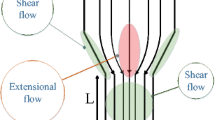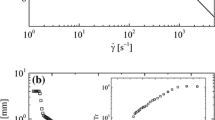Abstract
An analysis of the flow of polymer solutions through capillaries by means of pressure profiles was performed in this work. The experiments were carried out with aqueous solutions of flexible and semirigid macromolecules, Polyox and Xanthan respectively. The influence of the macromolecules' conformation on the flow field development is reflected on the different magnitudes of the entry length, being of the order of 60 diameters for the solutions of rigid macromolecules, and of the order of 10 diameters for flexible ones. In addition, the calculated end effects were larger for the rigid macromolecules than for the flexible ones. From these results, it is found that an increase in the entrance length is observed when the pseudoplastic behavior of the polymer solutions is increased.
Similar content being viewed by others
References
Boger DV, Binnington R (1977) Separation of elastic and shear thinning effects in the capillary rheometer. J Rheol 21:515–534
Choplin L (1980) Effets d'entrée et de sortie lors de l'écoulement de fluides polymériques dans une fente. Ph D Dissertation Thesis Université de Montréal
de Vargas L, Pérez-González J (1995) Evaluation of end effects in capillary rheometers for solutions of flexible polymers. J Rheol 39:125–137
Gottlieb M (1978) Ph D Dissertation. Chem Eng University of Wisconsin-Madison
Higashitani K, Lodge AS (1972) Hole pressure error measurements in pressure generated shear flow. Trans Soc Rheol 16:687–696
Malkus DS, Pritchard WG, Yao M (1992) The hole-pressure effect and viscometry. Rheol Acta 31:521–534
Okubo S, Hori Y (1979) Shear stress at wall and mean normal stress difference in capillary flow of polymer melts. J Rheol 23:625–649
Pérez-González J, de Vargas L, Tejero J (1992) Flow development of xanthan solutions in capillary rheometers. Rheol Acta 31:83–93
Walters K (1975) Rheometry. Chapman and Hall, London
Xia Y, Callaghan P (1991) Study of shear thinning in high polymer solutions using dynamic NMR microscopy. J Rheol 24:4777–4786
Author information
Authors and Affiliations
Additional information
Dedicated to Prof. Dr. J. Meissner on the occasion of his retirement from the chair of Polymer Physics at the Eidgenössische Technische Hochschule (ETH) Zürich, Switzerland
Rights and permissions
About this article
Cite this article
Pérez-Trejo, L., Méndez-Sánchez, A.F., Pérez-González, J. et al. Influence of polymer conformation on the entrance length in capillary flow. Rheol Acta 35, 194–201 (1996). https://doi.org/10.1007/BF00396046
Received:
Accepted:
Issue Date:
DOI: https://doi.org/10.1007/BF00396046




